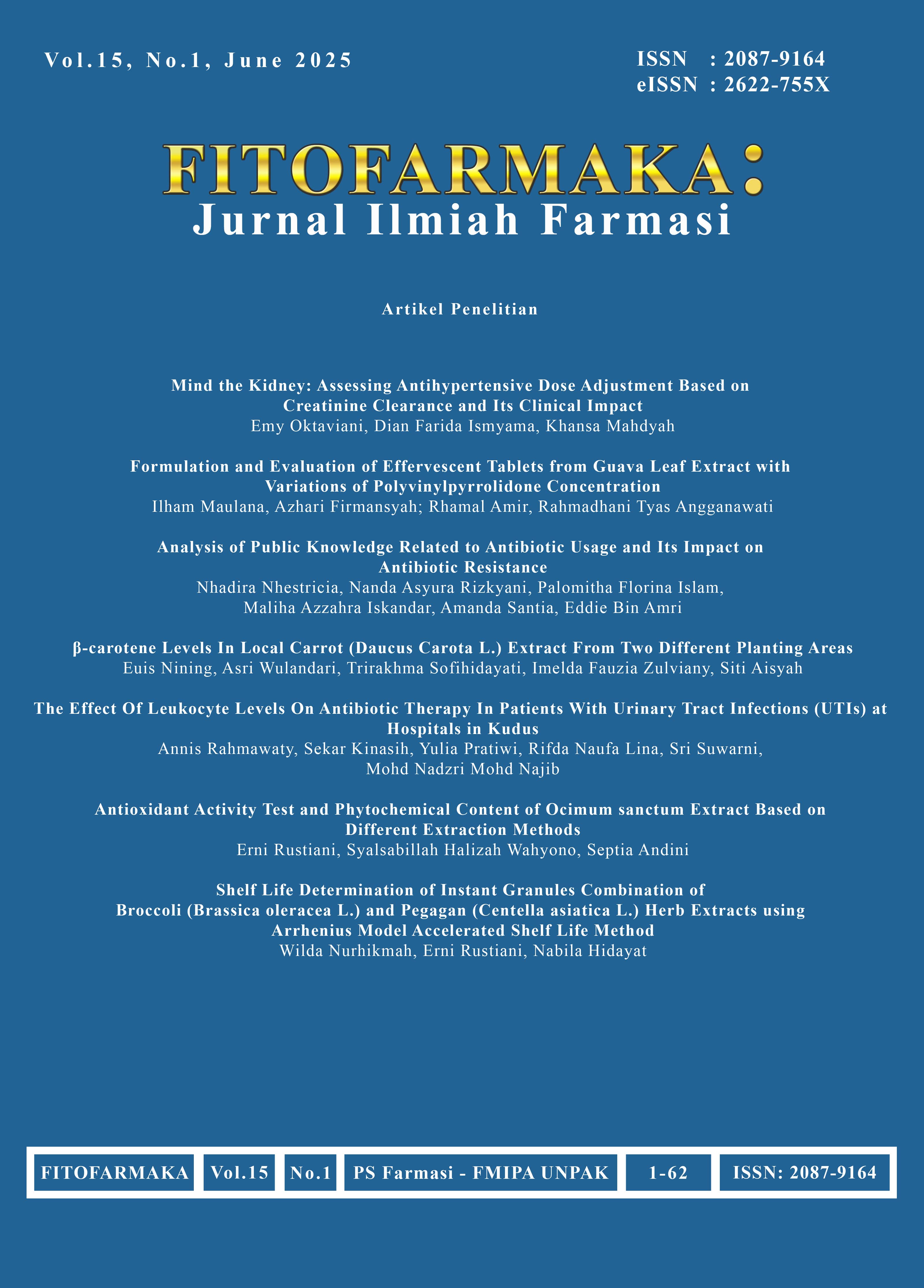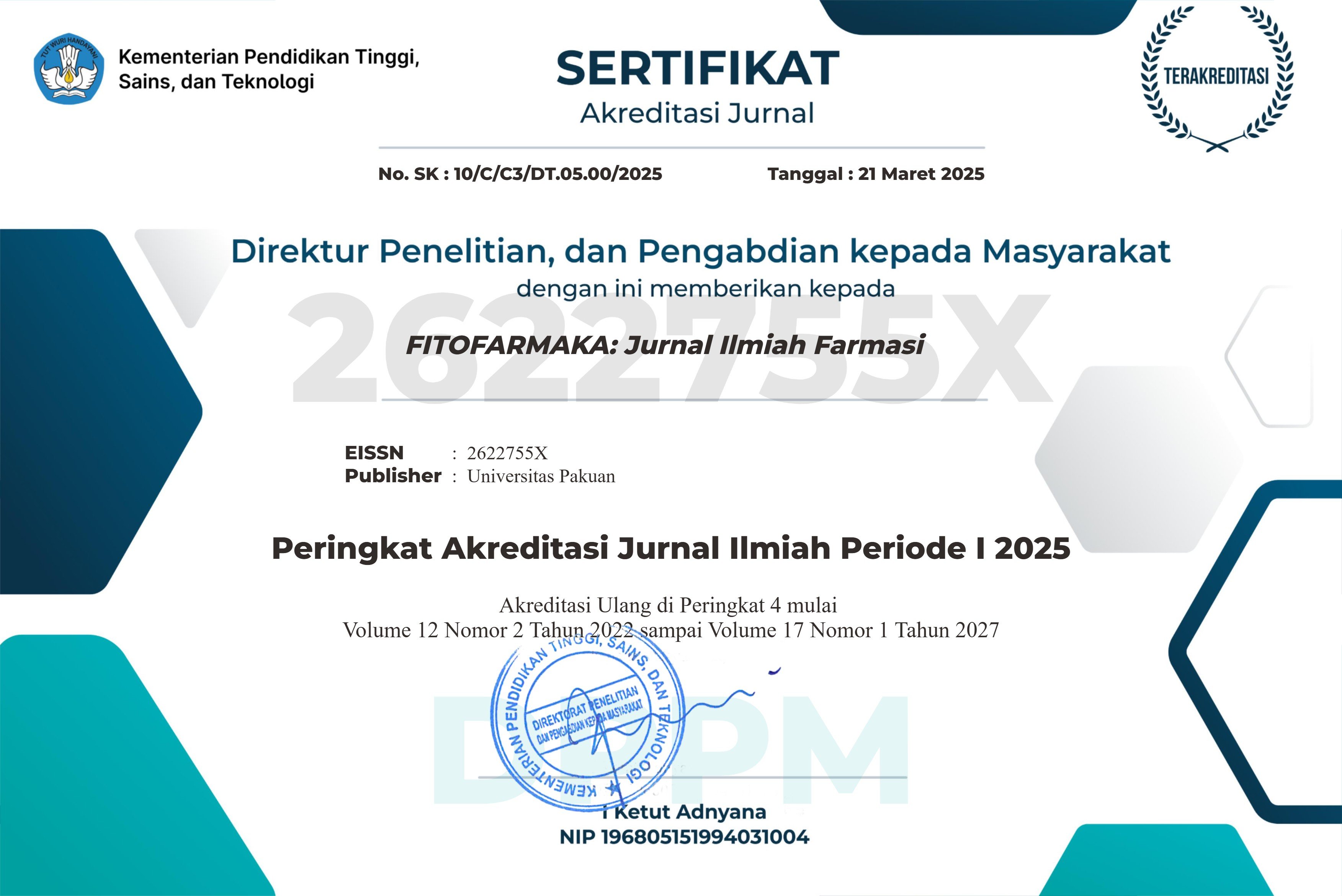Antioxidant Activity Test and Phytochemical Content of Ocimum sanctum Extract Based on Different Extraction Methods
Keywords:
antioxidants, DPPH, maceration, MAE, Ocimum sanctumAbstract
Ocimum sanctum, a member of the Lamiaceae family, is widely utilized in traditional medicine due to its pharmacological properties. Among its bioactive constituents, flavonoids exhibit significant antioxidant activity, capable of scavenging free radicals and inhibiting cancer growth and proliferation. This study aimed to evaluate the antioxidant activity and phytochemical composition of O. sanctum leaf extracts obtained using two different extraction techniques: maceration and Microwave-Assisted Extraction (MAE), and to determine the most effective method. The leaves were extracted using 70% ethanol, and the resulting extracts were analyzed qualitatively for the presence of phytochemical compounds. Antioxidant activity was assessed using the DPPH (2,2-diphenyl-1-picrylhydrazyl) assay, with vitamin C serving as the positive control. Absorbance measurements were performed at a wavelength of 516 nm using a visible spectrophotometer. Statistical analysis to determine the most effective extraction method was conducted using SPSS version 24. The results revealed that O. sanctum leaf extracts possess antioxidant activity, with IC₅₀ values of 111.843 ± 0.14789 ppm for the maceration method (moderate antioxidant intensity) and 75.725 ± 0.4498 ppm for the MAE method (strong antioxidant intensity). Qualitative phytochemical screening confirmed the presence of alkaloids, flavonoids, saponins, and tannins in both extraction methods, as well as in the powdered leaf material. The MAE method yielded the highest antioxidant activity, with an IC₅₀ value of 75.725 ± 0.4498 ppm, classifying it as a strong antioxidant source. Both extraction methods demonstrated the presence of key secondary metabolites, including alkaloids, flavonoids, saponins, and tannins.
References
Ambari, Y., Arlin, O.S., & Iif, H.N. (2021). Formulation and Activity Test of Body Lotion Ethanol Extract of Basil Leaves (Ocimum canum Sims.) Using the DPPH (1,1-diphenyl-2- picrylhydrazyl) Method. As-Syifaa Jurnal Farmasi, 13(2): 86-96.
Bennour, N., Mighri, H., Eljani, H., Zammouri, T., Akrout, A. (2020). Effect of solvent evaporation method on phenolic compounds and the antioxidant activity of Moringa oleifera cultivated in Southern Tunisia. South African Journal of Botany, 129:181-190. DOI: 10.1016/j.sajb.2019.05.005.
Bensaid, A., Boudard, F., Servent, A., Morel, S., Portet, K., Guzman, C., Vitou, M., Bichon, F., & Poucheret, P. (2022). Differential Nutrition Health Properties of Ocimum basilicum Leaf and Stem Extracts. Foods, 11(12):1699. DOI: 10.3390/foods11121699.
DepKes RI. (2014). Farmakope Indonesia Edisi V. Jakarta: Direktorat Jendral Pengawasan Obat dan Makanan.
Fatwami, E.F., & Royani, S. (2023). Phytochemical Screening and Antioxidant Test of Chili Leaf Extract (Capsicum frutescens L.). Journal Syifa Sciences and Clinical Research (JSSCR), 5(2): 253-260. DOI: 10.37311/jsscr.v5i2.20896.
Hanani,E. (2016). Analisis fitokimia. Jakarta: EGC.
Hassanpour, S.H., & Doroudi, A. (2023). Review of the antioxidant potential of flavonoids as a subgroup of polyphenols and partial substitute for synthetic antioxidants. Avicenna J Phytomed, 13(4): 354–376. DOI: 10.22038/AJP.2023.21774.
Jafar, W., Masriany, Eka, S. (2020). Phytochemical Test of Rain Tree Flower Extract (Spathodea campanulata) in Vitro. Proceedings of the National Biotic Seminar, 328-334.
Krismayadi, K., Halimatushadyah, E., Apriani, D., Cahyani, M.F. (2024). Standardization of the Quality of Simple Drugs and Ethanol Extract of Basil Leaves (Ocimum x africanum Lour.). Pharmacy Genius,, 32: 67-81. DOI:10.56359/pharmgen.v3i2.333.
Lopez-Salazar, H., Camacho-Diaz, H., Ocampo, M.L.A., & Jimenez-Aparicio, A.R. (2023). Microwave-assisted Extraction of Functional Compounds from Plants: A Review. BioResources,, 18(3): 6614-6638. DOI: 10.15376/biores.18.3.Lopez-Salazar.
Luthfiyanti, R., Iwansyah, A.C., Pamungkas, N.Y., & Triyono, A. (2020). Decreasing the Quality of Antioxidant Compounds and Water Content ToThe Shelf-Life Of Ciplukan (Physalis angulata Linn.) Leaf Extract Lozenges Candy. Jurnal Riset Teknologi Industri, 14(1): 1-12.
Madhuranga, H.D.T., & Samarakoon, N.A. (2023). Methods for determining in vitro antioxidant activity: Methodologies for the DPPH, FRAP, and H2O2 assays. Researchgate 7,4:1-7. (DOI: 10.23880/jonam-16000431).
Ministry of Health of Indonesia. 2024. Cancer Still Burdens the World. Data and Information Center of the Ministry of Health of the Republic of Indonesia, Jakarta.
Mulyani, E., Herlina, H., & Suci, K. (2022). Determination of Tannin Content of Pagoda Leaf Extract (Clerodendrum paniculatum) Using Visible Spectrophotometry and Permanganometric Titration Methods. Lumbung Farmasi Jurnal Ilmu Kefarmasian, 3(1): 7-11.
Ningsih, D.S., Henri, Roanisca, O., & Mahardika, R.G. (2020). Phytochemical Screening And Determination of Total Phenolic Content of Plant Leaf Extracts Sapu-sapu (Baeckea frutescens L.). BIOTROPIKA Journal of Tropical Biology, 8(3): 178-185.
(DOI: 10.21776/ub.biotropika.2020.008.03.06).
Quero-Jiménez, P.C., Felipe, L.A.A., López, L.R. (2020). Oil extraction and derivatization method: a review. MedCrave, 4(3): 110-120.
Rohmah, J., Ida, A.S., Luthfiyah, R., Fia, N., & Frida, A.M. (2021). Phytochemical Screening of Turi Leaf Extract (Sesbania grandiflora (L.) Pers) on Variations of Extraction Methods. Journal of Medical Laboratory Science Technology, 4(1): 22-29.
Rubianti, I., Nikman, A., Muh, N. (2022). Phytochemical Screening Analysis of Ethanol Extract of Golka Leaves (Ageratum conyziodes) as a Traditional Medicinal Plant for Ordinary People. Jurnal Sains dan Terapan, 1(2): 7-12.
Schubnell, M., De Caro, C.A., & Kunz, R. (2020). Moisture content, water content, loss on drying, Part 1: What exactly is meant and how are these quantities determined ?. In book: Thermal Analysis UserCom, 51:1-8. Mettler-Toledo Publisher, Publication No. 30595738.
Shofa, S.A. (2020). Phytochemical Screening and Identification of Secondary Metabolites by Thin Layer Chromatography (TLC) on Chitosan Nanoparticles from Garlic (Allium sativum Liin.), Jeringau (Acorus calamus L.), Mango Ginger (Curcuma mangga L.) Extracts, and Their Combinations. Fakultas Sains dan Teknologi, Universitas Islam Negeri Maulana Malik Ibrahim Malang.
Smith, A., Liline, S., & Sahetapy, S. (2023). Analysis of Ash Content in Red Zalak (Salacca edulis) In Riring Village and Buria Village, Taniwel District, West Seram Regency Maluku Province. Biopendix, 10(1): 51-57.
Tatiana, W.S., & Ria, S. (2020). Antioxidant Activity Test Using DPPH Method and Cytotoxic Test on T47D Breast Cancer Cells on Basil Leaf Extract. Jurnal Farmasetis : LPPM Sekolah Tinggi Ilmu Kesehatan Kendal, 9 (1),
https://doi.org/10.32583/farmasetis.v9i1.770
Umboro, R.O., Bimmaharyanto, D.E., Yanti, N.K.W. (2020). Antioxidant Effectiveness Test (IC50) And Acute Toxicity (LD50) Of Ethanol Fraction of Jackfruit Leaves (Artocarpus Heterophyllus Lam.). JUPE Jurnal Pendidikan Mandala, 5(6): 187-196.
Downloads
Published
How to Cite
Issue
Section
License
Copyright (c) 2025 FITOFARMAKA: JURNAL ILMIAH FARMASI

This work is licensed under a Creative Commons Attribution-ShareAlike 4.0 International License.








